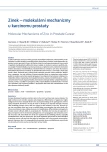The Role of Procalcitonin in the Differencial Diagnosis of Fever in Patiens with Multiple Myeloma
Authors:
K. Machálková; V. Maisnar
Authors‘ workplace:
II. interní klinika, Oddělení klinické hematologie, LF UK a FN Hradec Králové
Published in:
Klin Onkol 2011; 24(4): 298-301
Category:
Case Reports
Overview
Fever and elevated C-reactive protein are frequently found in hematooncological patients. It is sometimes difficult to distinguish between infectious fever and drug-related or tumour-associated fever. Tumour-related fever is not very common in multiple myeloma (unlike malignant lymphomas). C-reactive protein (CRP) is usually elevated simultaneously with fever and so it cannot be used in differential diagnosis of febrile states. There is another marker that provides information about the origins of the fever – procalcitonin. We present cases of three patients that illustrate the significance of procalcitonin in patients with multiple myeloma.
Key words:
multiple myeloma – procalcitonin – fever – C-reactive protein
Sources
1. Mitaka C. Clinical laboratory differentiation of infectious versus non-infectious systemic inflammtory response syndrome. Clin Chim Acta 2005; 351(1–2): 17–29.
2. Schüttrumpf S, Binder L, Hagemann T et al. Utility of procalcitonin concentration in the evaluation of patients with malignant diseases and elevated C-reactive protein plasma concentrations. Clin Infect Dis 2006; 43(4): 468–473.
3. Schüttrumpf S, Binder L, Hagemann T et al. Procalcitonin: a useful discriminator between febrile conditions and different origin in hemato-oncological patients? Ann Hematol 2003; 82(2): 98–103.
4. Šléglová O, Dejmková H, Uhrová J. Může stanovená hodnota sérového prokalcitoninu pomoci v diferenciální diagnoze mezi infekcí a akutním zhoršením u pacientů se systémovým autoimunitním onemocněním? Čes Revmatol 2010; 18(1): 4–11.
5. Bataille R, Boccadoro M, Klein B et al. C-reactive protein and beta2-microglobulin produce a simple and powerful myeloma staging system. Blood 1992; 80(3): 733–737.
6. Maisnar V, Toušková M, Malý J et al. Význam vybraných sledovaných laboratorních ukazatelů pro diferenciální diagnostiku a sledování aktivity mnohočetného myelomu. Vnitř Lék 2002; 48(4): 290–297.
7. Klein B, Zhang XG, Jourdan M et al. Paracrine rather than autocrine regulation of myeloma cell-growth and differentiation by interleukin-6. Blood 1989; 73(2): 517–526.
8. Ludwig J, Nachbaur DM, Fritz E et al. Interleukin-6 is a prognostic factor in multiple myeloma. Blood 1991; 77(12): 2794–2795.
9. Ballester OF, Moscinski LC, Lyman GH et al. High levels of interleukin-6 are associated with low tumor burden and low growth fraction in multiple myeloma. Blood 1994; 83(7): 1903–1908.
Labels
Paediatric clinical oncology Surgery Clinical oncologyArticle was published in
Clinical Oncology

2011 Issue 4
- Metamizole vs. Tramadol in Postoperative Analgesia
- Metamizole at a Glance and in Practice – Effective Non-Opioid Analgesic for All Ages
- Possibilities of Using Metamizole in the Treatment of Acute Primary Headaches
- Current Insights into the Antispasmodic and Analgesic Effects of Metamizole on the Gastrointestinal Tract
- Spasmolytic Effect of Metamizole
Most read in this issue
- Oropharyngeal Mucositis – Pain Management
- Schnitzler Syndrome: Diagnostics and Treatment
- Molecular Mechanisms of Zinc in Prostate Cancer
- The Role of Procalcitonin in the Differencial Diagnosis of Fever in Patiens with Multiple Myeloma
